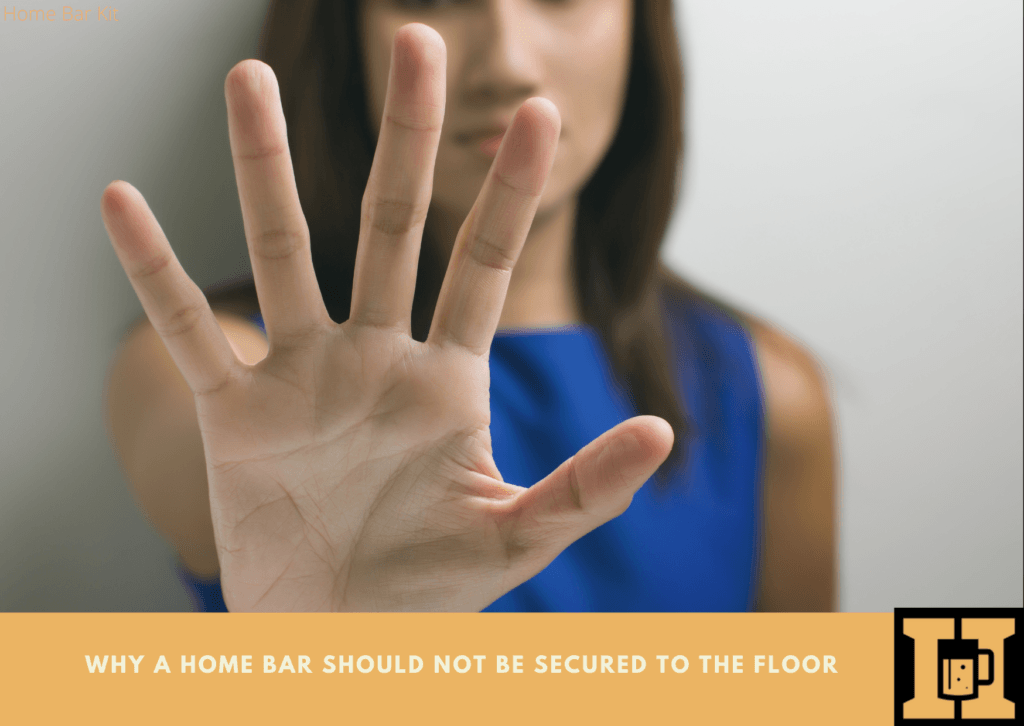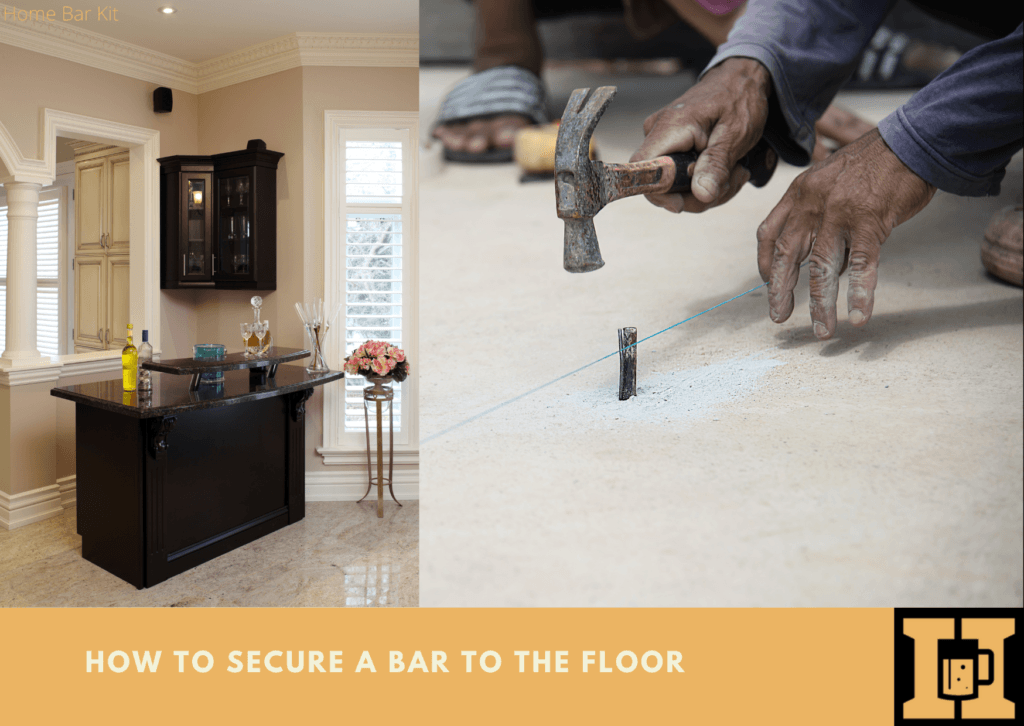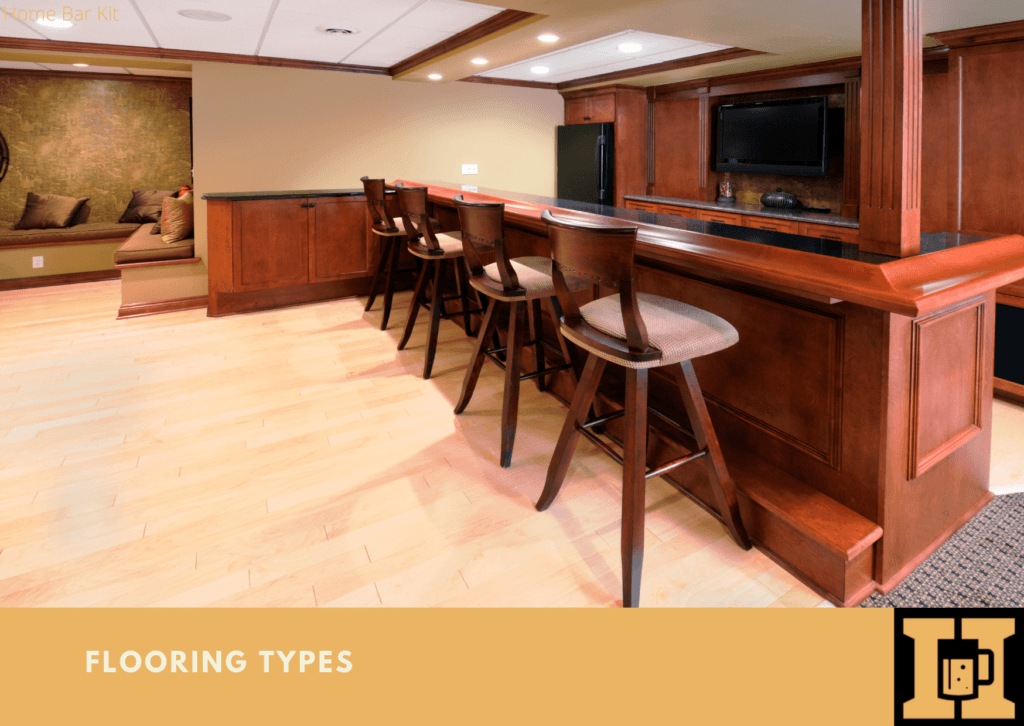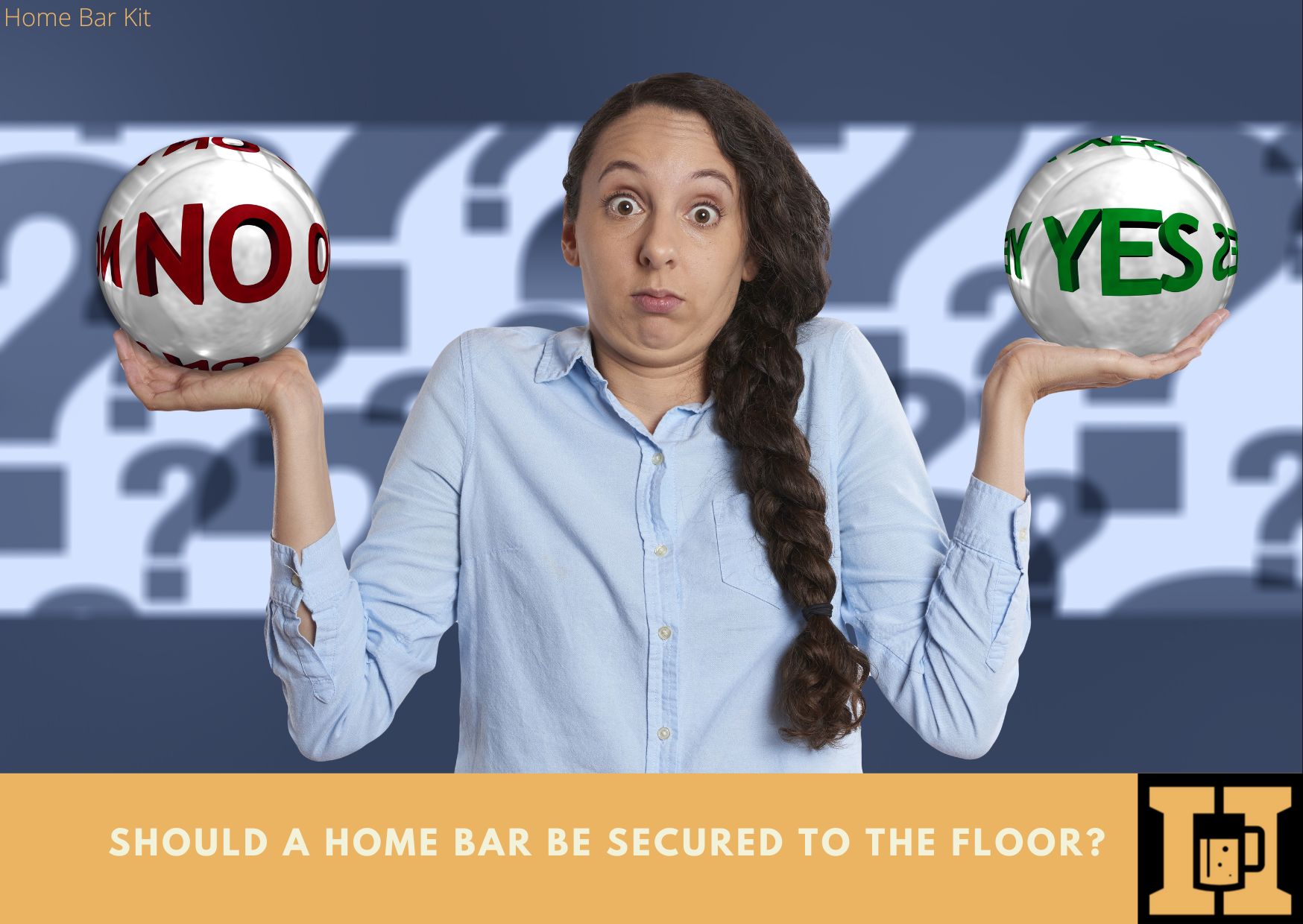Whether you purchase a ready made bar or build your own bar it is going to sit on the floor. Is it enough for the bar to just sit on the floor. Or should a home bar be secured to the floor?
For me it is a no brainer and I will share my thoughts going forward. However I am surprised at some of the views people have about whether to anchor a bar to the floor or not.
Should A Home Bar Be Secured To The Floor?
Of course it needs to be secured in place, like I said for me it’s a no brainer. A home bar will need to be anchored to the floor, or wall, or both. This will give peace of mind that the bar will not move if pushed in to, and has no chance of falling over with several people leaning against it.
However many people say there is no need to secure a home bar to the floor.
Why A Home Bar Should Not Be Secured To The Floor

Like I said there are many people that say there is no need to secure or anchor a home bar in position. A lot of these people actually have bars themselves and have not secured them in any way.
It obviously works for them, but for me a home bar still needs anchoring.
The Weight Will Hold It In Place
This is the argument from many, the bar is heavy enough to stay where it is placed. Gravity will keep it from moving apparently.
Now I agree that if a bar is of considerable size, then the weight may keep it from moving. Especially if the bar is a L-shape.
However I would still anchor it. As for smaller bars, well they might not have sufficient weight to stop them tipping with a little force.
Floor Surface Damage
Another reason why some people will not fix a bar to the floor or wall is because of damage. If the bar is taken out in the future, then there will be holes left in the floor or wall.
Fair point, however you just repair those holes. The same way you would if you moved a picture hanging on the wall.
Home Bar Reshuffle
Just as the bar may be taken out in the future, you may want to actually remodel your home bar in the future. This may involve relocating the bar to somewhere else in the space.
Again you will be left with holes where the bar was first situated. If you are remodelling then you will be expected some minor repairs anyway, the holes are just part of those repairs.
Why You Should Secure A Home Bar To The Floor
The clue is in the title, secure. A bar secured in place will not even move an quarter of an inch.
All my kitchen units which form almost a square are not only secured together, but also secured to the wall. This stops any movement and keeps the whole kitchen secured in place.
Even if the bar is heavy, there can still be movement over time. But for smaller bars that are lighter it becomes even more important to secure them.
Although the chances of a bar actually tipping over are slim, it could happen. And if it did, think of the possible damage.
Not only could it damage the floor, but also anything that is on or in the bar. Glasses on the shelves behind the bar could smash. Anything on the bar top is going for a smashing trip too.
The damage could be far more than a few small holes that are easily repaired.
How To Secure A Bar To The Floor

One end of a bar normally sits against a wall, so it can be fixed against the wall at that end. The other end can be fixed to the floor.
Always remember if you are doing any DIY yourself to use safety equipment, such as eye protection, ear protection and gloves.
Wall Type
A concrete or brick wall can be drilled using a masonry drill bit, plugged with a wall plug and then fixed with the appropriate size screw.
Before any holes are drilled, be sure to check the wall for buried electrical cables and pipes.
Stud walls will need to be drilled and fixed at the point of the studs. Drill a hole into the stud, and use the appropriate size screw for fixing.
The standard bar dimensions are 24″ (61cm) to 30″ (76cm) inches deep. The standard spacing for studs are 16″ (40cm) between centres. So your bar should line up with at least one stud to secure to.
Again check for cables and pipes before drilling any holes.
Flooring Types

A concrete floor can be drilled in the same way as the wall, with the right masonry drill bit. Although it can be fixed in the same way, there are plenty of fixings to choose from, such as anchor bolts.
Once again check for any pipes or such that might be under the concrete.
Wooden floors will be the same procedure as stud walls. However there are normally different spacings between joists depending on the size of the joists. Smaller joists will be spaced closer together than larger joists.
Also you need to find which way your joists are running in the room you are fixing the bar. Once you know which way your joists run, you can determine where your fixings points will be.
Make sure to check whether any cables or pipes have been notched into the joists before drilling.
Floor Coverings
The floor you are building your bar in may already have a floor covering. So you may be building directly on top of the floor covering.
Carpets and vinyl flooring should not pose a problem. Just be careful when making a hole in them, drilling them might not be the best idea. A carpet could snag and vinyl may rip.
It is far better to cut a small hole with a sharp knife at the point to be drilled.
Laminate flooring does float so it can expand and contract. It is best to drill an oversized hole in the laminate so it can move.
Tiled floors can be drilled easily with a drill bit designed for tiles. First drill a hole slightly bigger through the tile than the sub floor hole will be. Then using the right drill bit, drill the sub floor as above.
If of course you have underfloor heating, then it may not be viable to drill the floor at all.
The video shows a nice bit of kit that can fix to concrete floor with ease. An interesting tool, but not worth investing in if you are just doing a one off job. Unless of course they are available to hire.
Final Thoughts
I know many people do not secure their home bars to the floor or wall. That is fine if it works for them. However for me it should be fixed or secured in place, if only for peace of mind.
I am pretty sure that any commercial bar is always secured in place. Some even fix tables and bar stools to the floor.
It may be okay if you don’t fix your bar, but why take the chance.
If you haven’t secured your home bar, then do share your thoughts on why it doesn’t need it. On the other hand if you have fixed your home bar to the floor, again share your thoughts on how you did it.
Rob is a passionate home bar and pub shed enthusiast with a passion for craft beer. With hands-on experience in designing and building his own home bar, Rob shares his knowledge, tips, and inspiration to help fellow enthusiasts create their own perfect space. Alongside the world of home bars and pub sheds, Rob also explores the diverse and exciting realm of craft beer, providing honest reviews to help you discover your next favorite brew. Join Rob on a journey of flavor, design, and craftsmanship right here on Home Bar Kit.


I’m building an L-shaped bar with a 12″ wide base in my basement. The short part of the L will be 48″ long (this will give me a minimum of 30″ behind the bar with the bar top being 15-16′ wide. This portion will be anchored to the wall. The long side of the L will be 6ft long. The floor is 12″ square ceramic tile over concrete.
Two questions:
First, do I need to anchor the long side of the L to the floor?
If so, should I remove a row of tiles so that I can drill directly into the concrete? If not, how long should the anchors be to go far enough into the concrete to hold? (1-3/4″ wood plus 1/2″ tile/thinset plus ?)
Thanks.
Hi Mark,
Your bar sounds very much like the one I built for my pub shed, sounds good. I had every intention of fixing my bar to the floor and the wall. However once the bar was finished I found the weight of it didn’t justify fixing to either the wall or floor. It has been in place for over two years now and not moved at all. Being an L shape makes it stable so there is no rocking at all when anyone leans against it.
I would see what your bar feels like once built, can you move it easily? Is it stable in all directions (no rocking)? If so, like me there may be no need to fix to floor or wall.
But if you would prefer to fix to the floor anyway, you can leave the tiles in place as long as you use a proper tile drill to drill through the tiles so as not to chip or crack the tiles. I think a minimum of 4″ in depth will be sufficient.
I hope this helps and if you have any further question then let me know.
Enjoy your bar, cheers
Rob
What if there is radiant heat in the floor and the depth of the water tubing is unknown?
Hi Scott, I am not sure what you mean about radiant heat and water tubing depth in the floor. Let me know more details about what you mean, and if I can help then I will.
Cheers
Rob